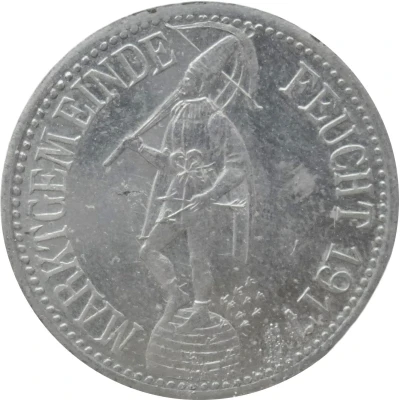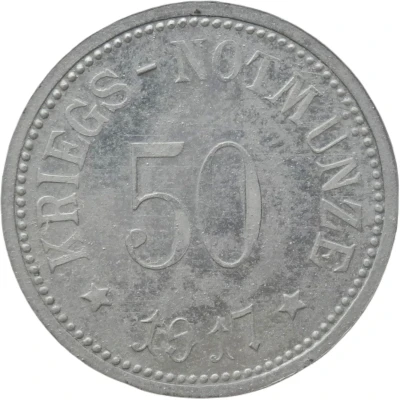


© Willem63 (CC BY-NC-SA)
50 Pfennigs - Feucht
1917 year| Zinc | 2.5 g | 22.5 mm |
| Issuer | Market Town of Feucht (Federal state of Bavaria) |
|---|---|
| Emperor | William II (Wilhelm II) (1888-1918) |
| Type | Standard circulation coin |
| Year | 1917 |
| Value | 50 Pfennigs (50 Pfennige) (0.50) |
| Currency | Mark (1914-1924) |
| Composition | Zinc |
| Weight | 2.5 g |
| Diameter | 22.5 mm |
| Thickness | 1.2 mm |
| Shape | Round |
| Technique | Milled |
| Orientation | Medal alignment ↑↑ |
| Demonetized | Yes |
| Updated | 2024-10-04 |
| Numista | N#264803 |
|---|---|
| Rarity index | 93% |
Reverse
Pearl rim, legend surrounding denomination.
Script: Latin
Lettering:
KRIEGS-NOTMÜNZE
50
★ 1917 ★
Edge
Plain
Comment
Interesting fact
The 50 Pfennigs - Feucht 1917 coin is interesting because it was issued during a time of economic turmoil in Germany, known as the "Inflationary Period" (1914-1923), when the value of the German mark dropped significantly due to the country's involvement in World War I and the subsequent economic crisis. As a result, the government had to issue new coins with lower denominations, such as the 50 Pfennigs, to keep up with the increasing prices and the need for smaller transactions. This coin, in particular, was minted in the Market Town of Feucht, which is now a part of the federal state of Bavaria, and it was made of zinc, a less valuable metal than the traditional copper or silver, but still durable and resistant to corrosion. Despite its relatively low value, this coin is a unique piece of history that reflects the economic and political circumstances of the time.
Price
| Date | Mintage | VG | F | VF | XF | AU | UNC |
|---|---|---|---|---|---|---|---|
| 1917 | 2000 | - | - | - | - | - | - |
Values in the table are based on evaluations by sales realized on Internet platforms. They serve as an indication only for 50 Pfennigs - Feucht 1917 coin.